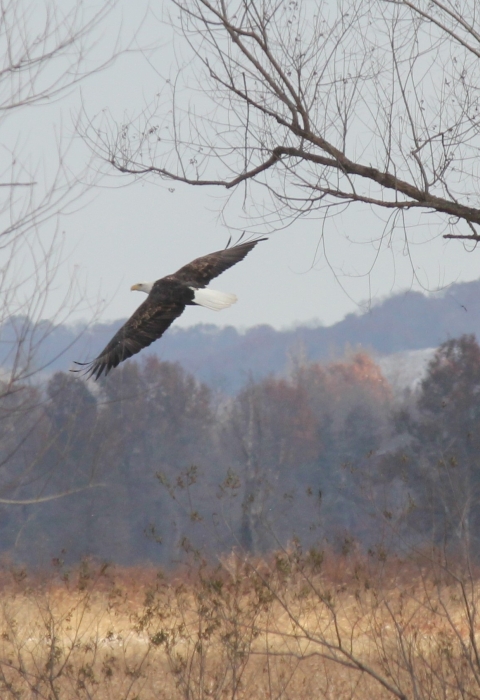How to avoid bald eagle nest disturbance, also known as a loss of productivity.
How can I avoid impacts to nesting bald eagles?
When planning your project, you should consider how your project may affect nearby nesting bald eagles, and how you can avoid and minimize your impacts. The U.S. Fish and Wildlife Service has developed the National Bald Eagle Management Guidelines to help people understand how bald eagles may react to various human activities and how you can reduce and minimize your project's impacts.
What type of nest disturbance permits are available for activities around bald eagle nests?
In 2024, the Service revised the regulations for the issuance of permits for eagle incidental take and eagle nest take under the Bald and Golden Eagle Protection Act. The revised regulations include a new system of general permits in addition to the specific-permit situations the Service has authorized in the past. You can read about different disturbance permit type and their availability on our Eagle Disturbance Take Permits and Nest Take Permits page. There are two broad categories of eagle disturbance permits:
Specific Permits for Eagle Disturbance
Specific permits for eagle nest disturbance are available stating April 12, 2024 and can be issued for up to 5 years. These permits are similar to nest disturbance permits that the Service has already been issuing to qualified applicants.
General Permits for Eagle Disturbance
General permits for eagle nest disturbance are anticipated to be available for issuance starting July 8, 2024, for activities beginning September 1, 2024 or later. General disturbance take permits are only issued for a maximum of one year, application will be through an online self-certification process. In the event these availability dates change, the Service will provide updated dates on https://www.fws.gov/regulations/eagle and the ePermits website https://epermits.fws.gov. The Service will continue to issue specific permits as appropriate for the remainder of the 2024 nesting season.
When is a permit recommended?
If your activity is greater than 660 feet from a bald eagle nest, or half a mile for loud activities such as explosions, your activity is unlikely to bother bald eagles to the degree that causes nest abandonment and a permit may not be recommended.
Please note:
- Bald eagles are unlikely to be disturbed by routine use of roads, homes or other facilities where such use was present before an eagle pair nested in a given area. For instance, if bald eagles build a nest near your existing home, cabin or place of business, you do not need a permit.
- Currently only specific permits are available for eagle nest disturbance. Once general permits for bald eagle nest disturbance are available, this information will be updated. You can review the types of activities that may qualify for for a bald eagle nest disturbance general permit here.
- A Nest Take Permit is ALWAYS required for an activity that removes, relocates, destroys or obstructs an eagle nest, even if the nest is not in-use (active).
| Distance | Time of Year | Activity | Recommendation |
| >660 feet | Any time | All (except blasting and other extremely loud activities) | No Eagle Disturbance Take permit |
| 330 to 660 feet (if similar activity within 660 feet) | Breeding season | All | Eagle Disturbance Take permit may not be recommended if eagles are tolerant of past disturbance; Contact your regional Migratory Bird Permit Office for Assistance. |
| 330 to 660 feet (no similar activity within 660 feet) | Breeding season | All | Eagle Disturbance Take recommended; Contact your regional Migratory Bird Permit Office for Assistance. |
| 330 to 660 feet | Outside of breeding season | Activity that will not be noticeable when the eagles return (tree trimming, pipe installation, etc) | Eagle Disturbance Take likely not recommended; Contact your regional Migratory Bird Permit Office for Confirmation. |
| <330 feet | Outside of Breeding Season | Tree clearing, building structures | Eagle Disturbance Take likely recommended; Contact your regional Migratory Bird Permit Office for Assistance. |
| <330 feet | Breeding Season | All | Eagle Disturbance Takerecommended; Contact your regional Migratory Bird Permit Office for Assistance. |
Next steps
Before you contact your regional Migratory Bird Permit Office for assistance, please have the following information prepared:
- Location of the bald eagle nest (latitude/longitude)
- Location of the planned project
- Type of project planned and long-term plans for the project
- Distance between the project and the bald eagle nest
- When the project will occur (what year, which months)
- How long the project will take
How do I know where eagle nests are located?
The U.S. Fish and Wildlife Service does not keep records of the locations of bald eagle nests; you are responsible for determining if there are eagle nest(s) near your project. The state, tribe(s) or others may have records of bald eagle nests in your area. Please use caution when querying any eagle nest databases. Information in these databases is often out of date - bald eagle nests may no longer exist, and or, new eagle nests may not be in the database. If you suspect there may be eagle nest(s) in your area, the best approach may be to survey the area for nests. You can start by familiarizing yourself with what bald eagle nests look like and examining the area. It may also help to ask neighbors in the area, and or, hire a biological consultant to determine this for you.
How do I know when bald eagle nesting season occurs?
Bald eagle nesting season varies by area of the country. To view a chart of nesting stages and dates, please review the National Bald Eagle Management Guidelines.
For additional information, see the frequently asked questions and instructions associated with Eagle Disturbance Take (Specific Permit) Application, 50 CFR 22.280 on our ePermits site.
Learn more about national bald eagle management guidelines.
Please note: These are general recommendations for land management practices that will benefit bald eagles, the document is intended primarily as a tool for landowners and planners who seek information and recommendations regarding how to avoid disturbing bald eagles. Many states and some tribal entities have developed state specific management plans, regulations, and or, guidance for landowners and land managers to protect and enhance bald eagle habitat; we encourage the continued development and use of these planning tools to benefit bald eagles.



